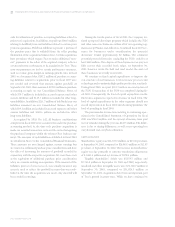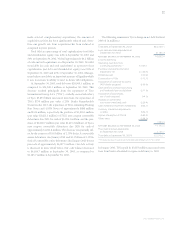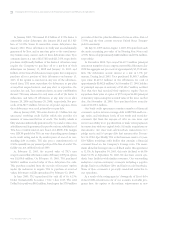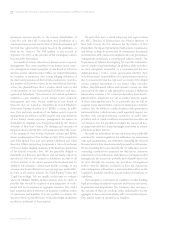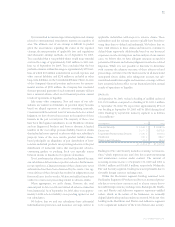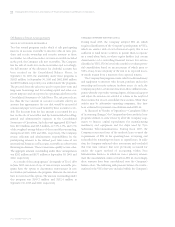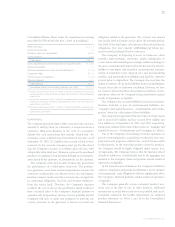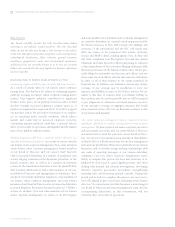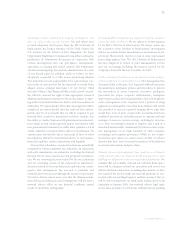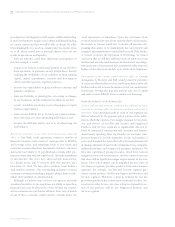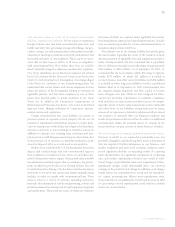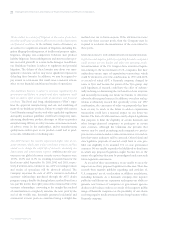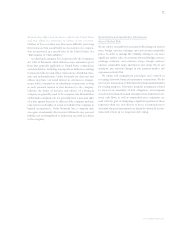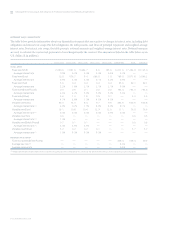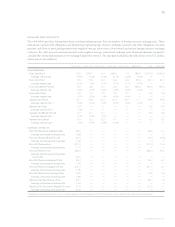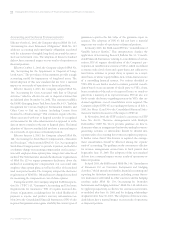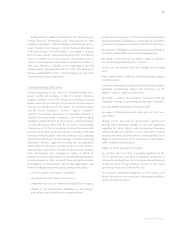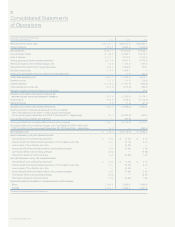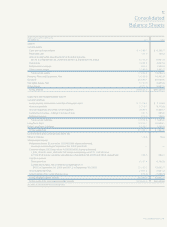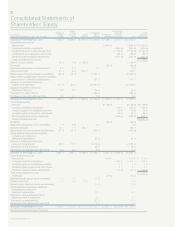ADT 2003 Annual Report Download - page 60
Download and view the complete annual report
Please find page 60 of the 2003 ADT annual report below. You can navigate through the pages in the report by either clicking on the pages listed below, or by using the keyword search tool below to find specific information within the annual report.
58
investigations and litigations could require additional funding.
If such developments require us to obtain additional funding,
we cannot assure you that we will be able to obtain the addi-
tional funding that we need on commercially reasonable terms
or at all, which would have a material adverse effect on our
results of operations and liquidity.
Such an outcome could have important consequences to
you. For example, it could:
•• require us to dedicate a substantial portion of our cash flow
from operations to payments on our indebtedness, thereby
reducing the availability of our cash flow to fund working
capital, capital expenditures, research and development
efforts and other general corporate purposes;
•• increase our vulnerability to general adverse economic and
industry conditions;
•• limit our flexibility in planning for, or reacting to, changes
in our businesses and the industries in which we operate;
•• restrict our ability to introduce new technologies or exploit
business opportunities;
•• make it more difficult for us to satisfy our payment obliga-
tions with respect to our outstanding indebtedness; and
•• increase the difficulty and/or cost to us of refinancing our
indebtedness.
Restrictive covenants in our debt instruments may adversely
affect us. Our bank credit agreements contain a number of
financial covenants, such as interest coverage, debt to EBITDA
and leverage ratios, and minimum levels of net worth and
restrictive covenants that limit the amount of debt we can incur
and restrict our ability to (i) pay dividends or make other pay-
ments in connection with our capital stock; (ii) make acquisitions
or investments; (iii) enter into sale/leaseback transactions;
(iv) pledge assets; and (v) prepay debt that matures after
December 31, 2004. We have three synthetic lease facilities
with similar covenants. Our outstanding indentures contain
customary covenants including a negative pledge, limit on sub-
sidiary debt and limit on sale/leasebacks.
Although we believe none of these covenants is presently
considered restrictive to our operations, our ability to meet these
financial ratios can be affected by events beyond our control,
and we cannot assure you that we will meet those tests. A breach
of any of these covenants could result in a default under our
credit agreements or indentures. Upon the occurrence of an
event of default under any of our credit facilities or indentures,
the lenders or trustees could elect to declare all amounts out-
standing thereunder to be immediately due and payable and
terminate all commitments to extend further credit. If the lenders
or trustees accelerate the repayment of borrowings, we cannot
assure you that we will have sufficient assets to repay our credit
facilities and our other indebtedness. Acceleration of any obliga-
tion under any of our material debt instruments will permit the
holders of our other material debt to accelerate their obligations.
Downgrades of our ratings would adversely affect us. Certain
downgrades by Moody’s and S&P would permit the providers
of our receivables facilities to cease further purchases under the
facilities and would increase the interest cost of our credit facility
borrowings. Downgrades may also increase our cost of capital
and make it more difficult for us to obtain new financing.
RISKS RELATING TO OUR BUSINESSES
Cyclical industry and economic conditions have affected and may
continue to adversely affect our financial condition and results of
operations. Our operating results in some of our segments are
affected adversely by the general cyclical pattern of the indus-
tries in which they operate. For example, demand for the prod-
ucts and services of our Fire and Security and Engineered
Products and Services segments is significantly affected by
levels of commercial construction and consumer and business
discretionary spending. Most importantly, our electronic com-
ponents business is heavily dependent on the end markets it
serves and therefore has been affected by the weak demand and
declining capital investment in the communications, computer,
industrial machine and commercial aerospace industries. We
have also experienced pricing pressures, which have reduced
margins in several of our businesses, and we cannot assure you
that there will be significant margin improvements in the near
future. This cyclical impact can be amplified because some of
our business segments purchase products from other business
segments. For example, our Fire and Security segment pur-
chases certain products sold by our Engineered Products and
Services segment. Therefore, a drop in demand for our fire
prevention products, due to lower new residential or office con-
struction or other factors, can cause a drop in demand for cer-
tain of our products sold by our Engineered Products and
Services segment.
TYCO INTERNATIONAL LTD.
Management’s Discussion and Analysis of Financial Condition and Results of Operations


